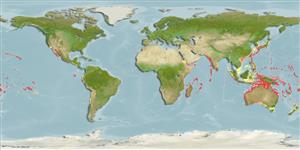Issue
EC GENERAMuraena is Atlantic and Mediterranean only.
Environment: milieu / climate zone / depth range / distribution range
Écologie
marin récifal; profondeur 5 - 60 m (Ref. 30874). Tropical
Indo-Pacific: Reunion to the Hawaiian, Line and Society islands, north to southern Japan (Ref. 559) and southern Korea, south to New Caledonia.
Taille / Poids / Âge
Maturity: Lm ? range ? - ? cm
Max length : 92.0 cm TL mâle / non sexé; (Ref. 54980)
Vertèbres: 119 - 126.
Inhabits coral and rocky reefs. Common in warm-temperate waters (Ref. 9710). Benthic at 1-35 m (Ref. 58302). Feeds on fishes (Ref. 9710). Minimum depth reported taken from Ref. 86942.
Life cycle and mating behavior
Maturité | Reproduction | Frai | Œufs | Fécondité | Larves
Chen, H.-M., K.-T. Shao and C.T. Chen, 1994. A review of the muraenid eels (Family Muraenidae) from Taiwan with descriptions of twelve new records. Zool. Stud. 33(1):44-64. (Ref. 6934)
Statut dans la liste rouge de l'IUCN (Ref. 130435: Version 2024-2)
Menace pour l'homme
Harmless
Utilisations par l'homme
Pêcheries: commercial; pêche sportive: oui; Aquarium: Commercial
Outils
Articles particuliers
Télécharger en XML
Sources Internet
Estimates based on models
Preferred temperature (Ref.
123201): 21.6 - 28.7, mean 27.3 °C (based on 530 cells).
Phylogenetic diversity index (Ref.
82804): PD
50 = 0.5002 [Uniqueness, from 0.5 = low to 2.0 = high].
Bayesian length-weight: a=0.00060 (0.00038 - 0.00096), b=3.30 (3.17 - 3.43), in cm total length, based on LWR estimates for this species & (Sub)family-body (Ref.
93245).
Niveau trophique (Ref.
69278): 4.5 ±0.80 se; based on food items.
Résilience (Ref.
120179): Faible, temps minimum de doublement de population : 4,5 à 14 années (Preliminary K or Fecundity.).
Fishing Vulnerability (Ref.
59153): High vulnerability (57 of 100).
Nutrients (Ref.
124155): Calcium = 28.2 [15.5, 45.1] mg/100g; Iron = 0.473 [0.281, 0.932] mg/100g; Protein = 18.8 [16.6, 21.4] %; Omega3 = 0.11 [0.05, 0.32] g/100g; Selenium = 43.2 [23.3, 87.3] μg/100g; VitaminA = 102 [31, 324] μg/100g; Zinc = 0.761 [0.529, 1.054] mg/100g (wet weight);
